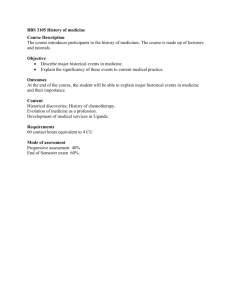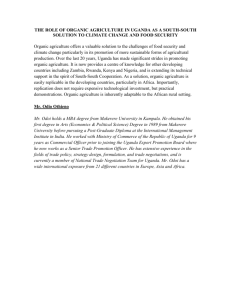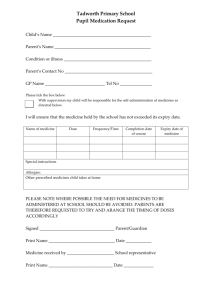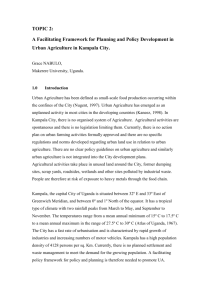Guidelines
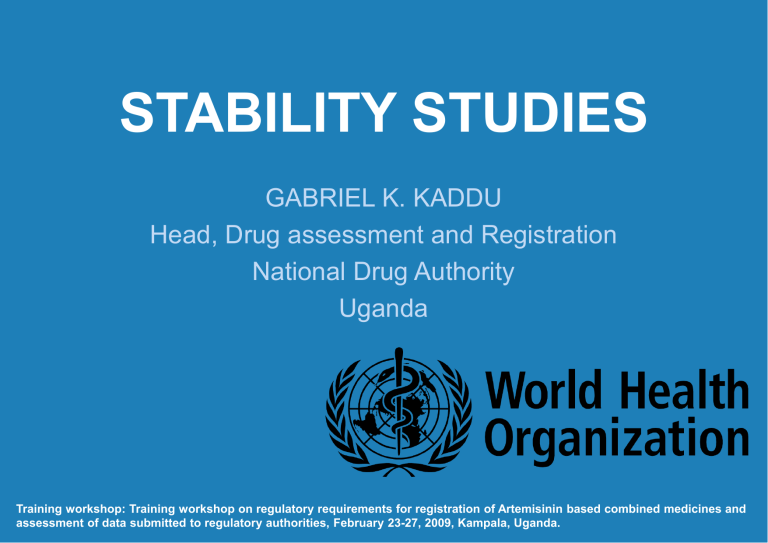
STABILITY STUDIES
GABRIEL K. KADDU
Head, Drug assessment and Registration
National Drug Authority
Uganda
Training workshop: Training workshop on regulatory requirements for registration of Artemisinin based combined medicines and assessment of data submitted to regulatory authorities, February 23-27, 2009, Kampala, Uganda.
Subjects for Discussion
5.
6.
7.
8.
1.
2.
3.
4.
Abbreviations
Applicable Guidelines
Selected definitions
Stability Protocol and Reports
Stability testing of API s
Stability testing of FPP s
Evaluation of results
Conclusion
2 |
Artemisinin based combined medicines
February 23-27, 2009, Kampala, Uganda
Abbreviations
API A ctive P harmaceutical I ngredient
EoI E xpression o f I nterest
FDC F ixedD ose C ombination
FPP F inished P harmaceutical P roduct
GMP G ood M anufacturing P ractices
ICH I nternational C onference on H armonization
MA M arketing A uthorization
DRA D rug R egulatory A uthority
Yellow → emphasis
3 |
Green
Artemisinin based combined medicines
February 23-27, 2009, Kampala, Uganda
→ WHO Blue → ICH
Applicable guidelines
WHO Guidelines for stability testing of pharmaceutical products containing well established drug substances in conventional dosage forms .
WHO working document QAS/05.146 - Stability Studies in a Global Environment.
ICH guidelines Q1A-Q1F. Stability testing of new APIs and FPPs has been harmonized at global level.
4 |
Artemisinin based combined medicines
February 23-27, 2009, Kampala, Uganda
Applicable guidelines
WHO Guideline on Submission of Documentation for
Prequalification of Multi-source ( Generic ) Finished
Pharmaceutical Products (FPPs) Used in the Treatment of HIV/AIDS, Malaria and Tuberculosis.
Annex 4.
Stability requirements for variations and changes to prequalified
FPPs
Supplement 2 Extension of the WHO List of Stable (not easily degradable ) APIs .
5 |
Artemisinin based combined medicines
February 23-27, 2009, Kampala, Uganda
Selected definitions
Re-test date
The date after which samples of an API should be examined to ensure that the material is still in compliance with the specification and thus suitable for use in the manufacture of a given FPP.
Shelf life (expiration dating period, conformance period)
The time period during which an API or a FPP is expected to remain within the approved shelf-life specification , provided that it is stored under the conditions defined on the container label.
6 |
Artemisinin based combined medicines
February 23-27, 2009, Kampala, Uganda
Selected definitions
Formal stability studies
Long term and accelerated (and intermediate) studies undertaken on primary and/or commitment batches according to a prescribed stability protocol to establish or confirm the re-test period of an API or the shelf life of a FPP.
Stress testing – forced degradation (API)
Studies undertaken to elucidate the intrinsic stability of the API. Such testing is part of the development strategy and is normally carried out under more severe conditions than those used for accelerated testing.
Stress testing – forced degradation (FPP)
Studies undertaken to assess the effect of severe conditions on the
FPP. Such studies include photostability testing (see ICH Q1B) and compatibility testing on APIs with each other in FDCs and API(s) with excipients during formulation development.
7 |
Artemisinin based combined medicines
February 23-27, 2009, Kampala, Uganda
Selected definitions
Primary batch
A batch of an API or FPP used in a formal stability study, from which stability data are submitted in a registration application for the purpose of establishing a re-test period or shelf life, respectively.
A primary batch of an
API should be at least a pilot scale batch. For a FPP, two of the three batches should be atleast pilot scale batch, and the third batch a production batch .
Commitment batches
Production batches of a drug substance or drug product for which the stability studies are initiated or completed post approval through a commitment made in the registration application .
8 |
Artemisinin based combined medicines
February 23-27, 2009, Kampala, Uganda
Selected definitions
Pilot (scale) batch
A batch of an API or FPP manufactured by a procedure fully representative of and simulating that to be applied to a full production scale batch . ( For solid oral dosage forms, a pilot scale is generally, at a minimum, one-tenth that of a full production scale or 100,000 tablets or capsules, whichever is the larger .)
Production (scale) batch
A batch of an API or FPP manufactured at production scale by using production equipment in a production facility as specified in the application.
9 |
Artemisinin based combined medicines
February 23-27, 2009, Kampala, Uganda
Selected definitions
Supporting data
Data, other than those from formal stability studies , that support the analytical procedures, the proposed re-test period or shelf life, and the label storage statements. Such data include
(1) stability data on early synthetic route batches of API, small-scale batches of materials, investigational formulations not proposed for marketing, related formulations, and product presented in containers and closures other than those proposed for marketing ;
(2) information regarding test results on containers; and
(3) other scientific rationales.
10 |
Artemisinin based combined medicines
February 23-27, 2009, Kampala, Uganda
Selected definitions
Specification - Release
The combination of physical, chemical, biological, and microbiological tests and acceptance criteria that determine the suitability of a drug product at the time of its release.
Specification - Shelf life
The combination of physical, chemical, biological, and microbiological tests and acceptance criteria that determine the suitability of an API throughout its re-test period, or that anFPP should meet throughout its shelf life.
Mass balance
The process of adding together the assay value and levels of degradation products to see how closely these add up to 100% of the initial value, with due consideration of the margin of analytical error.
11 |
Artemisinin based combined medicines
February 23-27, 2009, Kampala, Uganda
stability studies
Annex 3: Model Stability Protocol and Report
12 |
Artemisinin based combined medicines
February 23-27, 2009, Kampala, Uganda
Stability Protocol and Report
1.
2.
3.
4.
5.
6.
7.
8.
9.
10.
Batches tested
General information
Container/closure system
Literature and supporting data
Stability-indicating analytical methods
Testing plan
Test parameters
Test results
Other requirements (post-approval commitments)
Conclusions
Result sheets must bear date and responsible person signature /
QA approval
13 |
Artemisinin based combined medicines
February 23-27, 2009, Kampala, Uganda
Illustrative data of API stability batches
Batch number
Date of manufacture
Site of manufacture
Batch size (kg)
Primary packing materials
Date of initial analysis
The batches should be representative of the manufacturing process and should be manufactured from different batches of key intermediates.
14 |
Artemisinin based combined medicines
February 23-27, 2009, Kampala, Uganda
Illustrative data of capsule/tablet stability batches
Batch number
Date of manufacture
Site of manufacture
Batch size (kg)
Batch size (number of units)
Primary packing materials
Date of initial analysis
Batch number of the API
The batches should be representative of the manufacturing process and should be manufactured from different batches of APIs.
15 |
Artemisinin based combined medicines
February 23-27, 2009, Kampala, Uganda
2.7 Stability Testing API
2.7.1 Stress testing (forced degradation)
2.7.2 Regulatory stability testing
16 |
Artemisinin based combined medicines
February 23-27, 2009, Kampala, Uganda
ICH guidelines on stress testing
Standard Title and reference
ICH Q1A(R2) Stability Testing of New Drug Substances and Products
(the parent guideline)
ICH Q1B
ICH Q2B
Photostability Testing of New Drug Substances and
Products
Validation of Analytical Procedures: Methodology
ICH Q3A(R) Impurities in New Drug Substances
ICH Q3B(R) Impurities in New Drug Products
17 |
Artemisinin based combined medicines
February 23-27, 2009, Kampala, Uganda
Forced degradation tests
To identify potential degradants (degradation pathways) of the API and assess if they can be formed during manufacture or storage of the FPP ( intrinsic stability of the
API).
To validate the stability indicating power of the analytical procedures .
To identify stability-affecting factors such as ambient temperature, humidity and light and to select packing materials, which protect the FPP against such effects.
18 |
Artemisinin based combined medicines
February 23-27, 2009, Kampala, Uganda
Requirements for predictive stress conditions
Recommendations in Supplement 2:
Should lead to the degradation of the main compound, but not more than 5-15%.
Should lead to a good predictability of degradation pathways (i.e., a low probability of "drastic" or "false" degradation)
Should be conducted for no longer than three months .
19 |
Artemisinin based combined medicines
February 23-27, 2009, Kampala, Uganda
Stress testing of API in solution
Storage conditions pH ± 2, room temperature 2 weeks
Testing period* pH ± 7, room temperature pH ± 10-12, room temperature
2 weeks
2 weeks
H
2
O
2
, 0.1-2% at neutral pH, room temperature
24 hours
* Storage times given or 5-15% degradation, whatever comes first
20 |
Artemisinin based combined medicines
February 23-27, 2009, Kampala, Uganda
Regulatory or formal stability testing
Storage temperature
( ° C)
Accelerated: 40 ± 2
Intermediate: 30 ± 2
Long term: 25 ± 2
Relative humidity
(%)
75 ± 5
65 ± 5
60 ± 5
Minimum time period covered by data at submission (months)
6
12
12 (6)
21 |
Artemisinin based combined medicines
February 23-27, 2009, Kampala, Uganda
Stability results
A storage statement should be proposed for the labeling
(if applicable), which should be based on the stability evaluation of the API.
A re-test period should be derived from the stability information, and the approved retest date should be displayed on the container label.
An API is considered as stable if it is within the defined/regulatory specifications when stored at 30 ±2 o C and 65 ±5% RH for 2 years and at 40 ±2 o C and 75 ±5%RH for 6 months.
22 |
Artemisinin based combined medicines
February 23-27, 2009, Kampala, Uganda
3.11 Stability testing FPP
Regulatory stability testing
Stress testing (forced degradation)
23 |
Artemisinin based combined medicines
February 23-27, 2009, Kampala, Uganda
Potential instability issues of FPPs
Loss/increase in concentration of API
Formation of (toxic) degradation products
Modification of any attribute of functional relevance
Alteration of dissolution time/profile or bioavailability
Decline of microbiological status
Loss of package integrity
Reduction of label quality
Loss of pharmaceutical elegance and patient acceptability
24 |
Artemisinin based combined medicines
February 23-27, 2009, Kampala, Uganda
3.11.1 Stability-indicating quality parameters
Stability studies should include testing of those attributes of the FPP that are susceptible to change during storage and are likely to influence quality, safety and/or efficacy. For instance, in case of tablets:
♦ appearance
♦ friability
♦ dissolution time ♦
♦ assay ♦
♦
♦ hardness moisture content degradants microbial purity
25 |
Artemisinin based combined medicines
February 23-27, 2009, Kampala, Uganda
3.11.3 Selection of Batches
At the time of submission data from stability studies should be provided for batches of the same formulation and dosage form in the container closure system proposed for marketing.
Stability data on three primary batches are to be provided. The composition, batch size, batch number and manufacturing date of each of the stability batches should be documented and the certificate of analysis at batch release should be attached.
Where possible, batches of the FPP should be manufactured by using different batches of the API .
26 |
Artemisinin based combined medicines
February 23-27, 2009, Kampala, Uganda
Significant Change of FPPs
A 5% change in assay from its initial value.
Any degradation product exceeding its acceptance criterion .
Failure to meet the acceptance criteria for appearance, physical attributes , and functionality test (e.g., color , phase separation, hardness).
As appropriate for the dosage form , e.g., failure to meet the acceptance criteria for dissolution for 12 dosage units.
27 |
Artemisinin based combined medicines
February 23-27, 2009, Kampala, Uganda
2.2.3 Tests at elevated temperature and/or extremes of humidity (ICH-Q1F)
Special transportation and climatic conditions outside the storage conditions recommended in this guideline should be supported by additional data .
For example , these data can be obtained from studies on one batch of drug product conducted for up to 3 months at 50 °C/ambient humidity to cover extremely hot and dry conditions and at 25 °C/80% RH to cover extremely high humidity conditions.
Stability testing at a high humidity condition , e.g., 25 °C/80% RH, is recommended for solid dosage forms in water-vapour permeable packaging, e.g., tablets in PVC/aluminum blisters , intended to be marketed in territories with extremely high humidity conditions in Zone IV. However, for solid dosage forms in primary containers designed to provide a barrier to water vapour, e.g.
aluminum/aluminum blisters, stability testing at a storage condition of extremely high humidity is not considered necessary.
28 |
Artemisinin based combined medicines
February 23-27, 2009, Kampala, Uganda
Stress testing of FPPs in solid state
Storage conditions Testing period*
40°C, 75 % RH; open storage** 3 months
50-60
°C, ambient RH; open storage
Photostability; according to ICH
3 months according to ICH
* 3 months or 5-15% degradation, whatever comes first
** For API1-API2, or API-excipient, or FPP without packing material, typically a thin layer of material is spread in a Petri dish. Open storage is recommended, if possible.
29 |
Artemisinin based combined medicines
February 23-27, 2009, Kampala, Uganda
Stability studies
API and FPP
Evaluation of results
30 |
Artemisinin based combined medicines
February 23-27, 2009, Kampala, Uganda
3.11.10 Evaluation
A systematic approach should be adopted in the presentation and evaluation of the stability information.
Where the data show so little degradation and so little variability that it is apparent from looking at the data that the requested shelf life will be granted, it is normally unnecessary to go through the formal statistical analysis; providing a justification for the omission should be sufficient .
An approach for analysing data on a quantitative attribute that is expected to change with time is to determine the time at which the 95% one-sided confidence limit for the mean curve intersects the (lower) acceptance criterion (95% assay).
31 |
Artemisinin based combined medicines
February 23-27, 2009, Kampala, Uganda
Evaluation
1.
Tabulate and plot stability data on all attributes at all storage conditions and evaluate each attribute separately .
2.
No significant change at accelerated conditions within six (6) months.
3.
Long-term data show little or no variability and little or no change over time .
32 |
Artemisinin based combined medicines
February 23-27, 2009, Kampala, Uganda
Evaluation
4.
Accelerated data show little or no variability and little or no change over time.
5.
Statistical analysis is normally unnecessary.
6.
Proposed retest period or shelf life = double of period covered by long-tem data (X) but NMT X + 12 months
7.
A retest period or shelf life granted on the basis of extrapolation should always be verified by additional long-term stability data
33 |
Artemisinin based combined medicines
February 23-27, 2009, Kampala, Uganda
Release and shelf-life specifications
It may be appropriate to have justifiable differences between the shelf life and release acceptance criteria based on the stability evaluation and the changes observed on storage.
Shelf-life acceptance criteria should be derived from consideration of all available stability information.
Release and shelf-life dissolution acceptance criteria
34 |
Artemisinin based combined medicines
February 23-27, 2009, Kampala, Uganda
Commitment
For confirmation of provisional (tentative) shelflife, real-time data are required
First 3 production batches on stability
Follow up stability testing ( FUST ) – one batch per year
35 |
Artemisinin based combined medicines
February 23-27, 2009, Kampala, Uganda
Additional or New Stability Data
Variations affecting one or more steps of the same route of synthesis of an API
Change in the route of synthesis of an API
Change in composition of the FPP
Change in immediate packaging of the FPP
36 |
Artemisinin based combined medicines
February 23-27, 2009, Kampala, Uganda
Conclusion
Stability studies should be planned on the basis of pharmaceutical R+D and regulatory requirements .
Forced degradation studies reveal the intrinsic chemical properties of the API , while formal stability studies establish the retest date .
The shelf life (expiry date) of FPPs is derived from formal stability studies.
Variability and time trends of stability data must be evaluated by the manufacturer in order to propose a retest date or expiry date.
37 |
Artemisinin based combined medicines
February 23-27, 2009, Kampala, Uganda
38 |
Artemisinin based combined medicines
February 23-27, 2009, Kampala, Uganda
